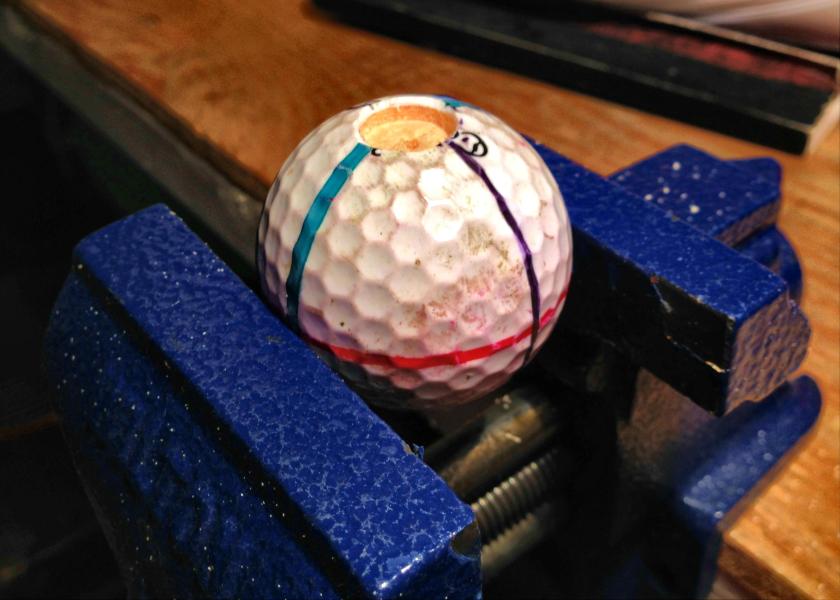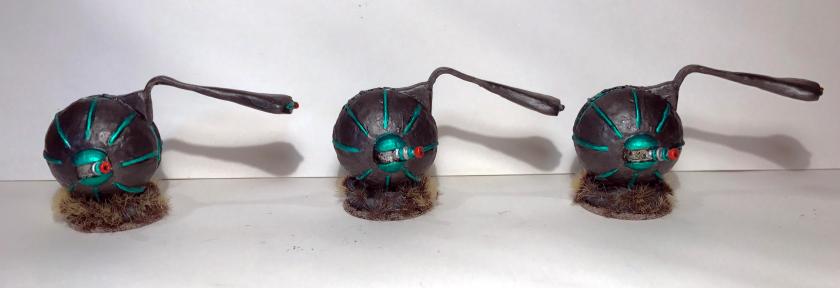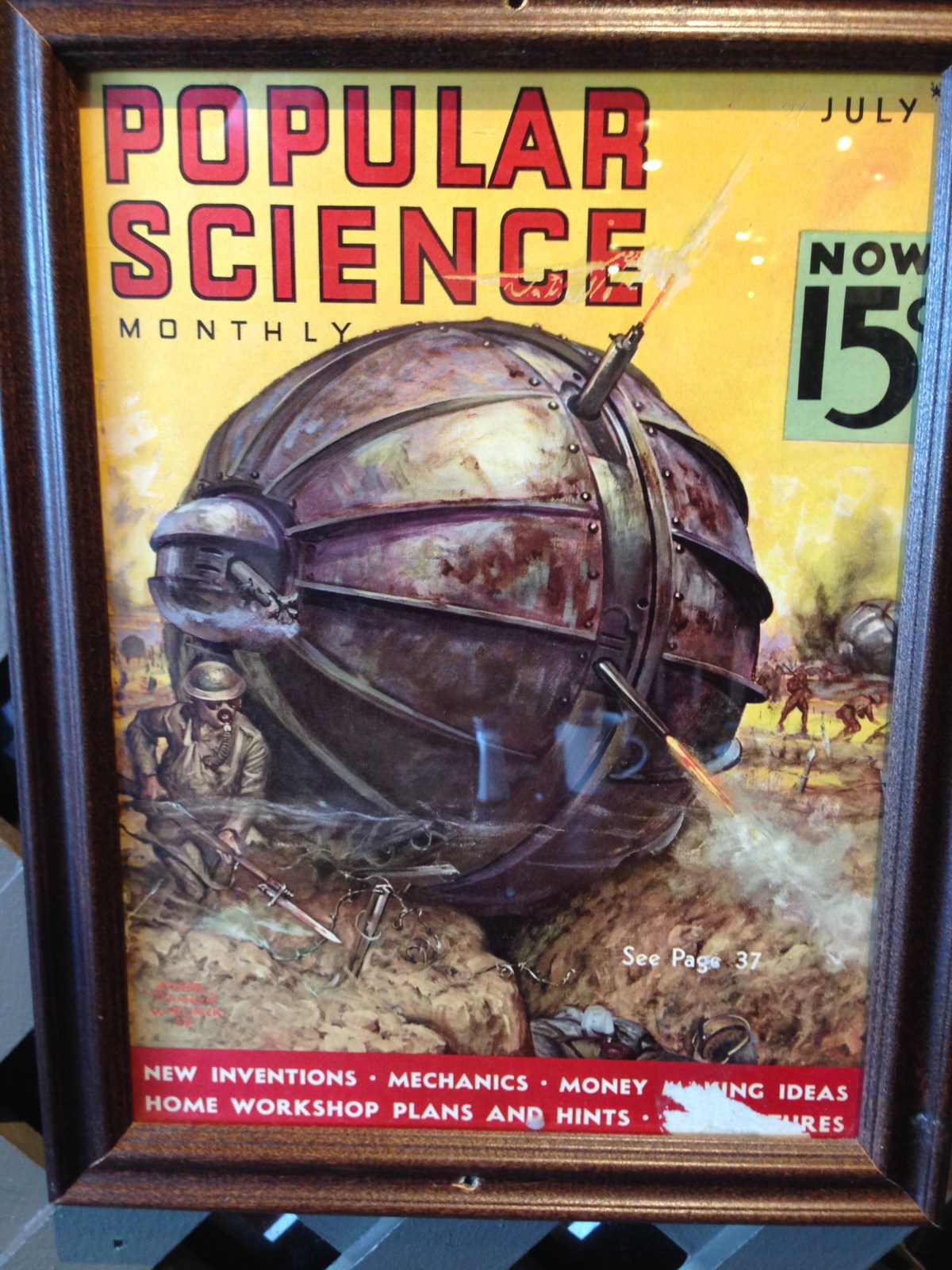I am happy to begin the 2017 blogging season with a very complicated project. While I began work on this project in December, I had been thinking about it since last May.
So what happened in May 2016? I was traveling for work, and sat down in a Cracker Barrel in Connecticut for breakfast (Uncle Herschel’s with a sweet tea of course). For those of you who have never been to a Cracker Barrel, there are always old photos and curios all over the walls. I looked to my left, and saw this on the wall:

I was amazed at this and wanted to dig in more and learn the date of this issue of Popular Science magazine and see what the article said. The article was just a paragraph with another picture – here is the link and a shot of the July 1936 article on page 37.

The concept of the “tumbleweed tank” tank was one of two outer shell halves rotating independently on rollers over a solid stationary sphere. More or less, the outer halves acted as the vehicle’s treads. I do not believe that anyone ever tried to build this as a combat vehicle, but I still found the concept fascinating and worthy of a project.
During the intervening months, I conceived of an idea that I could make a model of the tank, build a mold, and cast it for tabletop wargaming. As I have been building units of Star Rovers figures for sci-fi Combat Patrol™, my first thought was to make a retro-sci-fi tank, probably for the Frinx. I was not enthusiastic about the weapons design as shown in the magazine – machine guns alone would make this a very boring retro sci-fi tank. I also considered making it modular – so that I could adapt different weapons for it.
While thinking about it, I wanted to have a great sphere – and my sculpting experience is at best weak to nonexistent. I have seen a few blogs that I follow where folks are sculpting their own figures, and that helped to inspire me. As I also cast – this was a chance to go from beginning to end with the project. But what to use?
The answer came easily to me as a golfer – a golf ball! That would be an easy thing to work with and would afford me a chance to see what works. I had an idea that I wanted it to be armed with ray guns in the side sponsons. I had not decided on the main weapon, when I had a brainstorm – 1953’s War of the Worlds Martian Heat Rays!


So with this plan, I went forward to try to create my new Mark 1’s (what else to call them!). I thought that I could learn from the project (and I have). I used a “Line ’em Up” golf accessory to create lines on a used Callaway golf ball, and drilled a ½” hole in the side of the ball on two sides. I like the Callaway for this as it has hexagonal dimples.

After this, I used a Plastruct 2mm x 4.8mm styrene strip to size up the gap between the ball halves. I used my Dremel to cut the outer surface of the ball – it ended up being messy and needed a lot of Exacto knife work. The Dremel cutting blade tends to melt the outer ball cover – another lesson learned

I then needed to create the tread ridges. I used an Exacto knife to carve small channels along the lines for the treads. This took a lot of cutting! Using some old plastic membership cards, I cut out each tread, sized them to the holes, and glued them in with super glue.

I then drilled a ¼” hole for the attachment of a main weapon – which I would cast separately with the sponsons in a single mold. To build a base for the model, I used three 1¼” washers, and glued them together with wood glue. I then covered them with Apoxie Sculpt, leaving a hole to mount the ball to the base with a wood screw through the washer. This ended up being a base that I feel in the end was a little too tall, but usable, and castable.

I originally was going to use Milliput or Apoxie Sculpt for the sponsons – when I discovered these ½” Button Plugs from Lara’s Crafts – which were the right shape and fit perfectly into the holes on the sides (got lucky here). I bought a set of Niji woodcarving knives (which I wish I had when I was carving the treads and the middle gap!) and used them to make the sponson shells. After trial and error (where I learned the hard way that I needed to wear a cutting glove with these very sharp knives), I carved two sponsons and sanded down the middle slots.

I initially thought that I needed to smooth out the golf ball dimples and the tread cuts, so I first tried with Apoxie Sculpt, with poor results. My next attempt was with Citadel “Liquid Green Stuff”, which was better, but I think was an unneeded step.

I drilled a 1/8″ hole in the sponson shell, and mounted a short piece of Evergreen Scale Models strip styrene 1/8″ tube. For the ray guns, I turned to the use of model airplane parts. I used two Dubro products – a 2mm socket head cap screw with three 2 mm flat washers superglued to it. To line up the washers evenly, I found that using toothpicks on both sides and underneath to define the gaps and make the washers relatively parallel worked well. I inserted the guns into the ends of the styrene, after coring out the ends of the styrene rods for a better fit. Eventually, I primed the sponsons black with Citadel “Imperium Primer”, as I wanted there to be less tackiness to the Quick-Sil from the wood.


I then moved onto the main weapon, the heat ray. In the 1953 movie, the heat ray was rectangular, leading to the distinctive head. I eyeballed the length, and designed the head. I sculpted it in two stages, with the “eye” section being attached to the neck, which itself was on the Plastruct strip styrene.


I cut the styrene strip to size, and used more Apoxie Sculpt to make a mount that would fit into the main weapon recess. After it hardened, I saw that I would have to bend it in my mold, or otherwise I would have a very turtle-like appearance. As the styrene is flexible, this was not a problem. I made two two-piece molds with Castaldo Quick-Sil – one for the chassis and one for the weapons. I also tried some new innovations with venting with the use of some more model airplane parts – in this case flexible fuel lines that I cut for venting. As you can see below, I bent the heat ray in the mold to my desired shape.




In the end, the mold for the weapons worked very well, needing little work on the finished weapons. However, the chassis mold had a few issues. First, I knew as a golfer that golf balls compress when struck. What I did not realize was that there would be a strong interaction of the flattish sponson holes and the pressure exerted by the curing Quick-Sil on them at 90° angles. As a result, the cast ball would be visibly compressed somewhat. Additionally, the flow was not perfect – leading to my needing to add Apoxie Sculpt to the finished models’ chassis. Lastly, because the mold for the chassis was thick, and the casting was large, it took a long time to cool, and used a lot of metal (see phots for weight below in the blog). Unfortunately I discovered this when I opened the mold once and the metal flowed out! I will incorporate these lessons learned into the Mark 2’s.


I managed to successfully cast two chassis, and decided to use the master as well as I already had the mold. So I cast three sets of weapons, and assembled three tanks in total. I used some Apoxie Sculpt to fill in the gaps in the back where flow was less than ideal -and this worked fine. Next, I mounted the assembled tanks to a 1 5/8″ steel washer for magnetic storage in my gaming boxes.

I then primed the tanks with Citadel “Imperium Primer” – I must say I like this as a brush primer – it’s a nice product.

After priming, I moved on to painting them. Painting these proved to be challenging, especially the fully-cast models, due to the weight of the models. The metal ones weighed about 14 ounces, while the master weighed in at 4 ounces!
I used Citadel “XV-88” on the base and the chassis gaps. For the chassis and the heat ray, I based with Tamiya “Gun Metal”. I used several light coats and had a shiny finish to deal with – but a smooth one. The trick with Tamiya is a wet brush and a lot of shaking and shaking again. I then used another Tamiya metallic, “Chrome Silver” to paint the sponsons, the tread ridges, and the business end of the heat rays. I painted the tips pf the ray guns and the “eye” of the heat ray with “XV-88” and Citadel “Gehenna’s Gold” in anticipation of future colors. The base I gave an application of Americana “Ebony”.

I then used my new Citadel Technical paints. Remember that the Martian craft had orbs that were glowing green. To recreate that feel, I applied two coats of Citadel “Waystone Green” to the sponson tops and bottoms, the tread ridges, the chassis gaps, and the main portion of the heat ray. I also painted the first and last rings of the ray guns with this technical paint. I wanted the slot of the sponson to be a bit darker – and Secret Weapons Washes “Armor Wash” helped me to achieve that look. For the tips of the ray guns and the “eye” of the heat ray, Citadel “Spiritstone Red” gave a nice focal character to the weapons.

To accent the green, I shaded areas around the “Waystone Green” with Citadel “Nuln Oil GLOSSY”. As I was going to dull down the overall shiny paint job, I thought this would work better – and I think it did. I drybrushed the bases with Citadel “Mechanicus Standard Gray”, and then applied a light flocking with Army Painter “Ash Grey” on the washer alone.

I was now ready to varnish, and for the first time I used Army Painter’s “Anti-Shine” matte varnish. This is an aqueous varnish. I liked it, and am excited as varnishing in New England in the winter is always a logistical challenge. I uses 2 parts varnish to 1 part water, and applied with a fan brush lightly. It came out nice and smooth. After it dried, I sprayed the models with Testors “Dullcoat” is my cellar bulkhead after I got it warm enough. This enabled venting of the fumes outside after I was done and kept my wife from killing me when she got home!
To finish the models, I needed to deal with the elevated bases. Using a lot of Army Painter “Wasteland Tuft” applied with white glue, I was able to create an image of the tanks plowing through grass. They are heavy though, but sturdy.


Here are some close up photos of the final product.




I am very happy with how these came out. If I get enough interest, I may offer some for sale as kits. Certainly, these are my first real creations from conception to creating to molding to casting to painting. I learned a lot, and I am sure that my next iterations will be better.
They will be an excellent part of my Frinx forces for Combat Patrol™!



Good cast!
Sorry, I can’t help thinking that they will topple over at any moment because of the protruding main weapon… 😀
…I could foresee that in a distant future discovered in WH40k universe by orc archelogizs they would be equipped with certain extra skullz and spikez and then used as hammer to squash enemies in close combat…
LikeLiked by 1 person
Thanks! I like that they can be used for different forces. The weight of the chassis absolutely precludes tipping – one good point of the weight!
LikeLike
Ma’k:
Great work. From conception through casting and then the final outcome, this is an excellently-executed project. I am very impressed.
I like the color scheme you chose as well. I am a huge fan of the early War of the Worlds movie, and really like the way the eye/ray weapon turned out.
I hope you figure out how to lighten them a bit and then make them available for sale. My retro science fiction figures need some armored support.
Buck
LikeLiked by 1 person
Thanks Buck and I agree – if naught but to reduce the metal content! The chassis will be lighter and hopefully the modular nature of the tank will enable variety by the modeler. Glad you like the color scheme – the Citadel Technical paints work very well if used properly with silver or gold underneath- have yet to try the blue. Mark 2’s are in progress. I have to say, when you responded to my message with the 1936 magazine cover that you could build them, that was my inspiration! Thanks for that!
LikeLike
Wow!! This is genius. You have restored my faith in the human brain sir. Great work.
LikeLiked by 1 person
Thank you! I am working on the next version already!
LikeLiked by 1 person